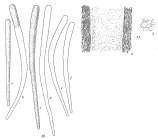Foraminifera taxon details
Micatuba Avnimelech, 1952
111987 (urn:lsid:marinespecies.org:taxname:111987)
accepted
Genus
Bathysiphon flexilis Höglund, 1947 accepted as Micatuba flexilis (Höglund, 1947) (type by original designation)
Rhabdogromia Valkanova, 1964 · unaccepted (Objective synonym, Loeblich and...)
Objective synonym, Loeblich and Tappan (1987)
marine, fresh, terrestrial
Avnimelech, M. (1952). A revision of the tubular Monothalamia. <em>Contributions from the Cushman Foundation for Foraminiferal Research.</em> 3(2): 60-68., available online at https://cushmanfoundation.allenpress.com/portals/_default/files/pubarchive/CCFFR/03ccffr2.pdf [details] Available for editors  [request]
[request]
Hayward, B.W.; Le Coze, F.; Vachard, D.; Gross, O. (2024). World Foraminifera Database. Micatuba Avnimelech, 1952. Accessed at: https://marinespecies.org/foraminifera/aphia.php?p=taxdetails&id=111987 on 2024-04-20
Date
action
by
original description
Avnimelech, M. (1952). A revision of the tubular Monothalamia. <em>Contributions from the Cushman Foundation for Foraminiferal Research.</em> 3(2): 60-68., available online at https://cushmanfoundation.allenpress.com/portals/_default/files/pubarchive/CCFFR/03ccffr2.pdf [details] Available for editors  [request]
[request]
original description (of Rhabdogromia Valkanova, 1964) Valkanova, C., 1964, Über eine neue Rhizopodengattung- Rhabdogromia, Zoologischer Anzeiger 172:258-261.
page(s): p. 260 [details]
basis of record Gross, O. (2001). Foraminifera, <B><I>in</I></B>: Costello, M.J. <i>et al.</i> (Ed.) (2001). <i>European register of marine species: a check-list of the marine species in Europe and a bibliography of guides to their identification. Collection Patrimoines Naturels,</i> 50: pp. 60-75 (look up in IMIS) [details]
additional source Loeblich, A. R.; Tappan, H. (1987). Foraminiferal Genera and their Classification. Van Nostrand Reinhold Company, New York. 970pp., available online at https://books.google.pt/books?id=n_BqCQAAQBAJ [details] Available for editors [request]
[request]
original description (of Rhabdogromia Valkanova, 1964) Valkanova, C., 1964, Über eine neue Rhizopodengattung- Rhabdogromia, Zoologischer Anzeiger 172:258-261.
page(s): p. 260 [details]
basis of record Gross, O. (2001). Foraminifera, <B><I>in</I></B>: Costello, M.J. <i>et al.</i> (Ed.) (2001). <i>European register of marine species: a check-list of the marine species in Europe and a bibliography of guides to their identification. Collection Patrimoines Naturels,</i> 50: pp. 60-75 (look up in IMIS) [details]
additional source Loeblich, A. R.; Tappan, H. (1987). Foraminiferal Genera and their Classification. Van Nostrand Reinhold Company, New York. 970pp., available online at https://books.google.pt/books?id=n_BqCQAAQBAJ [details] Available for editors
From editor or global species database
Diagnosis Test very narrow and elongate, length about 25 times the breadth and from 0.6 mm to 2.1 mm, tapering gradually toward the base, then somewhat inflated and clavate, inflated portion commonly broken free and giving the appearance of two apertures, although close examination shows a secondarily formed partition closing the open end; wall with organic base, strengthened by imbricated layers of mica flakes of 5 µm to 15 µm diameter, the layers curving outward toward the base of the test, allowing the test to remain flexible; aperture at the opposite end of the tube that constricts to about half its previous diameter when the cytoplasm is retracted but that may expand and flare as the pseudopodia are extended, aperture surrounded by a neck with thickened wall lacking mineral particles; granular cytoplasm completely fills the test, distinct pseudopodial trunk gives rise to long, thin, rarely anastomosing pseudopodia, cytoplasmic streaming at about 3 µm to 4 µm per second, during life the movement of the animal commonly leaves an accumulation of detritus around the aperture but this is absent from dead specimens, nucleus central in position. Holocene; Bulgaria: shallow water, from interstitial sands on the beach to 12 m depth on Black Sea coast; Sweden: 7 m to 109 m depth. (Loeblich & Tappan, 1987, Foraminiferal Genera and Their Classification) [details]
